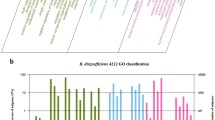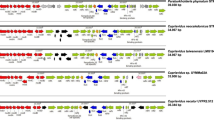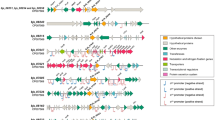Abstract
Competitiveness for nodulation is one of the major restrictive factors in symbiotic nitrogen fixation between rhizobia and their host legumes. Soybean root exudates that include a variety of compounds are thought to act as signals to trigger the early symbiotic events between Bradyrhizobium diazoefficiens and soybeans, and thus they act as a key determinant of the competitiveness for nodulation. To gain a better understanding of the molecular mechanism of competitiveness at the level of protein expression, we compared the proteomic responses of two B. diazoefficiens strains that demonstrated completely different nodulation abilities, strain 4534 being the most competitive and strain 4222 being the least competitive in nodulation. In the proteomic analysis, 40 of the 65 and 22 of the 29 differential proteins were identified in response to soybean root exudates in strain 4534 and strain 4222, respectively. Compared to strain 4222, a higher amount and a number of differential proteins were detected in strain 4534, including S-adenosylmethionine synthetase (SAMS), PhyR-σEcfG regulon, ABC-type transporters, flagellar proteins, molecular chaperones, and proteins involved in redox state maintenance as well as several unknown proteins. Noteworthy was the induction of the PhyR-σEcfG regulon and flagellar proteins, recently demonstrated to be involved in the competitiveness for nodulation in Bradyrhizobium japonicum. Our results indicate that the role of root exudates can go far beyond inducing the expression of nodulation genes in B. diazoefficiens. Many other proteins/enzymes involved in the metabolism and environmental fitness were also upregulated when exposed to root exudates. More proteins were upregulated by the high nodulation competitive strain than that by the low, and the reasons for this need further investigation. The outcome of such study may contribute to our understanding of molecular mechanisms of different competitiveness in B. diazoefficiens as well as specific adaptation in the legume host.

Similar content being viewed by others
References
Albareda M, Dardanell MS, Sousa C, Megías M, Temprano F, Rodríguez-Navarro DN (2006) Factors affecting the attachment of rhizospheric bacteria to bean and soybean roots. FEMS Microbiol Lett 259:67–73
Aneja P, Zachertowska A, Charles TC (2005) Comparison of the symbiotic and competition phenotypes of Sinorhizobium meliloti PHB synthesis and degradation pathway mutants. Can J Microbiol 51:599–604
Argaw A (2012) Evaluation of co-inoculation of Bradyrhizobium japonicum and phosphate solubilizing Pseudomonas spp. effect on soybean (Glycine max L. (Merr.)) in Assossa area. J Agric Sci Tech-Iran 14:213–224
Barbour WM, Hattermann DR, Stacey G (1991) Chemotaxis of Bradyrhizobium japonicum to soybean exudates. Appl Environ Microbiol 57:2635–2639
Beringer JE (1974) R factor transfer in Rhizobium leguminosarum. J Gen Microbiol 120:421–429
Bogino P, Banchio E, Bonfiglio C, Giordano W (2008) Competitiveness of a Bradyrhizobium sp. strain in soils containing indigenous rhizobia. Curr Microbiol 56:66–72
Bradford MM (1976) A rapid and sensitive method for the quantitation of microgram quantities of protein utilizing the principle of protein dye binding. Anal Biochem 72:248–254
Cesco S, Mimmo T, Tonon G, Tomasi R, Pinton R, Terzano R, Neumann G, Weisskopf L, Renella G, Landi L, Nannipieri P (2012) Plant-borne flavonoids released into the rhizosphere: impact on soil bio-activities related to plant nutrition. A review. Biol Fertil Soils 48:123–150
Cooper JE (2004) Multiple responses of rhizobia to flavonoids during legume root infection. Adv Bot Res 41:1–62
Covelli JM, Althabegoiti MJ, López MF, Lodeiro AR (2013) Swarming motility in Bradyrhizobium japonicum. Res Microbiol 164:136–144
Cytryn EJ, Sangurdekar DP, Streeter JG, Franck WL, Chang WS, Gar S, Emerich DW, Joshi T, Xu D, Sadowsky MJ (2007) Transcriptional and physiological responses of Bradyrhizobium japonicum to desiccation-induced stress. J Bacteriol 189:6751–6762
D’Haeze W, Holsters M (2002) Nod factor structures, responses, and perception during initiation of nodule development. Glycobiology 12:79–105
Da Silva Batista JS, Hungria M (2012) Proteomics reveals differential expression of proteins related to a variety of metabolic pathways by genistein-induced Bradyrhizobium japonicum strains. J Proteomics 75:1211–1219
David F, Peoples MB, Boddey RM (2008) Global inputs of biological nitrogen fixation in agricultural systems. Plant Soil 311:1–18
Davies BW, Walker GC (2007) Identification of novel Sinorhizobium meliloti mutants compromised for oxidative stress protection and symbiosis. J Bacteriol 189:2110–2113
Delamuta JR, Ribeiro RA, Ormeño-Orrillo E, Melo IS, Martínez-Romero E, Hungria M (2013) Polyphasic evidence supporting the reclassification of Bradyrhizobium japonicum group Ia strains as Bradyrhizobium diazoefficiens sp. Nov Evol Microbiol 63:3342–3351
Donati AJ, Lee HI, Leveau JH, Chang WS (2013) Effects of indole-3-acetic acid on the transcriptional activities and stress tolerance of Bradyrhizobium japonicum. PLoS One 8:76559
Edwards A, Frederix M, Wisniewski F, Jones J, Zorreguieta A, Downie JA (2009) The cin and rai quorum-sensing regulatory systems in Rhizobium leguminosarum are coordinated by ExpR and CinS, a small regulatory protein coexpressed with CinI. J Bacteriol 191:3059–3067
Ferrer JL, Austin MB, Stewart CJ, Noel JP (2008) Structure and function of enzymes involved in the biosynthesis of phenylpropanoids. Plant Physiol Biochem 46:356–370
Fujishige NA, Lum MR, De Hoff PL, Whitelegge JP, Faull KF, Hirsch AM (2008) Rhizobium common nod genes are required for biofilm formation. Mol Microbiol 67:504–515
Giagnoni L, Magherini F, Landi L, Taghavi S, Modesti A, Bini L, Nannipieri P, Vanderlelie D, Renella G (2011) Extraction of microbial proteome from soil: potential and limitations assessed through a model study. Eur J Soil Sci 62:74–81
Göttfert MP, Grob H, Hennecke (1990) Proposed regulatory pathway encoded by the nodV and nodW genes, determinants of host specificity in Bradyrhizobium japonicum. Proc Natl Acad Sci U S A 87:2680–2684
Göttfert MP, Holzhäuser D, Bäni D, Hennecke H (1992) Structural and functional analysis of two different nodD genes in Bradyrhizobium japonicum USDA110. Mol Plant Microbe Interact 5:257–265
Gourion B, Francez- Charlot A, Vorholt JA (2008) PhyR is involved in the general stress response of Methylobacterium extorquens AM1. J Bacteriol 190:1027–1035
Gourion B, Sulser S, Frunzke J, Francez-Charlot A, Stiefel P, Pessi G, Vorholt JA, Fischer HM (2009) The PhyR-σEcfG signalling cascade is involved in stress response and symbiotic efficiency in Bradyrhizobium japonicum. Mol Microbiol 73:291–305
Hempel J, Zehner S, Göttfert M, Patschkowski T (2009) Analysis of the secretome of the soybean symbiont Bradyrhizobium japonicum. J Bacteriol 140:51–58
Hoffmann A, Bukau B, Kramer G (2010) Structure and function of the molecular chaperone trigger factor. Biochim Biophys Acta 1803:650–661
Hungria M, Boddey LH, Santos MA, Vargas MA (1998) Nitrogen fixation capacity and nodule occupancy by Bradyrhizobium japonicum and B. elkanii strains. Biol Fertil Soils 27:393–399
Jones KM, Kobayashi H, Davies BW, Taga ME, Walker GC (2007) How symbionts invade plants: the Sinorhizobium-Medicago model. Nat Rev Microbiol 5:619–633
Juge C, Prévost D, Bertrand A, Bipfubusa M, Chalifour FP (2012) Growth and biochemical responses of soybean to double and triple microbial associations with Bradyrhizobium, Azospirillum and arbuscular mycorrhizae. Appl Soil Ecol 61:147–157
Kape R, Parniske M, Werner D (1991) Chemotaxis and nod gene activity of Bradyrhizobium japonicum in response to hydroxycinnamic acids and isoflavonoids. Appl Environ Microbiol 57:316–319
Kape R, Parniske M, Brandt S, Werner D (1992) Isoliquiritigenin, a strong nod gene- and glyceollin resistance-inducing flavonoid from soy-bean root exudate. Appl Environ Microbiol 58:1705–1710
Kawamura Y, Uemura M (2003) Mass spectrometric approach for identifying putative plasma membrane proteins of Arabidopsis leaves associated with cold acclimation. Plant J 36:141–154
Kennedy JA, Powell HKJ (1985) Polyphenol interactions with aluminum(III) and iron(III)—their possible involvement in podzolization process. Aust J Chem 38:879–888
Kidaj D, Wielbo J, Skorupska A (2012) Nod factors stimulate seed germination and promote growth and nodulation of pea and vetch under competitive conditions. Microbiol Res 167:44–50
Lang K, Lindemann A, Hauser F, Göttfert M (2008) The genistein stimulon of Bradyrhizobium japonicum. Mol Genet Genomics 279:203–211
Lee HI, Lee JH, Park H, Sangurdekar D, Chang WS (2012) Effect of soybean coumestrol on Bradyrhizobium japonicum nodulation ability, biofilm formation, and transcriptional profile. Appl Environ Microbiol 78:2896–2903
Li J, Xiao WL, Ma MC, Guan DW, Jiang X, Cao FM, Shen DL, Chen HJ, Li L (2011) Proteomic study on two Bradyrhizobium japonicum strains with different competitivenesses for nodulation. Agric Sci China 10:10721079
Liu H, Wang C, Komatsu S, He M, Liu G, Shen S (2013) Proteomic analysis of the seed development in Jatropha curcas: from carbon flux to the lipid accumulation. J Proteomics 91:23–40
Loh J, Garcia M, Stacey G (1997) NodV and NodW, a second flavonoid recognition system regulating nod gene expression in Bradyrhizobium japonicum. J Bacteriol 179:3013–3020
López-García SL, Vázquez TE, Favelukes G, Lodeiro AR (2002) Rhizobial position as a main determinant in the problem of competition for nodulation in soybean. Environ Microbiol 4:216–224
López-García SL, Perticari A, Piccinetti C (2009) In-furrow inoculation and selection for higher motility enhances the efficacy of Bradyrhizobium japonicum nodulation. Agric J 101:357–363
Mabood F, Souleimanov A, Khan W, Smith DL (2006) Jasmonates induce Nod factor production by Bradyrhizobium japonicum. Plant Physiol Biochem 44:759–765
Mabood F, Jung WJ, Smith DL (2008) Signals in the underground: microbial signaling and plant productivity. In: Nautiyal CS, Dion PE, Chopra VL (eds) Molecular mechanisms of plant and microbe coexistence. Springer, Berlin, pp 291–318
Mark GL, Dow JM, Kiely PD, Higgins H, Haynes J, Baysse C, Abbas A, Foley T, Franks A, Morrissey J, O’Gara F (2005) Transcriptome profiling of bacterial responses to root exudates identifies genes involved in microbe-plant interactions. Proc Natl Acad Sci U S A 102:17454–17459
Marroquí S, Zorreguieta A, Santamaría C, Temprano F, Soberón M, Megías M, Downie JA (2001) Enhanced symbiotic performance by Rhizobium tropici glycogen synthase mutants. J Bacteriol 183:854–864
McInnes A, Thies JE, Abbott LK, Howieson JG (2004) Structure and diversity among rhizobial strains, populations and communities—a review. Soil Biol Biochem 36:1295–1308
Mongiardini EJ, Pérez-Gimenez J, Althabegoiti MJ, Covelli J, Ignacio Quelas J, López-García SL, Lodeiro AR (2009) Overproduction of the rhizobial adhesin RapA1 increases competitiveness for nodulation. Soil Biol Biochem 41:2017–2020
Mueller K, González JE (2011) Complex regulation of symbiotic functions is coordinated by MucR and quorum sensing in Sinorhizobium meliloti. J Bacteriol 193:485–496
Nicolás MF, Barcellos FG, Hess PN, Hungria M (2007) ABC transporters in Mycoplasma hyopneumoniae and Mycoplasma synoviae: insights into evolution and pathogenicity. Genet Mol Biol 30:2002–2011
Nomura M, Arunothayanan H, VanDao T (2010) Differential protein profiles of Bradyrhizobium japonicum USDA110 bacteroid during soybean nodule development. Soil Sci Plant Nutr 56:579–590
Oldroyd GE, Murray JD, Poole PS, Downie JA (2011) The rules of engagement in the legume-rhizobial symbiosis. Annu Rev Genet 45:119–144
Palacios OA, Bashan Y, de-Bashan LE (2014) Proven and potential involvement of vitamins in interactions of plants with plant growth-promoting bacteria—an overview. Biol Fertil Soils 50:415–432
Perez-Giménez J, Mongiardini EJ, Althabegoiti MJ, Covelli J, Quelas JI, López-García SL, Lodeiro AR (2009) Soybean lectin enhances biofilm formation by Bradyrhizobium japonicum in the absence of plants. Int J Microbiol 1. doi: 10.1155/2009/719367
Prell J, Poole P (2006) Metabolic changes of rhizobia in legume nodules. Trends Microbiol 14:161–168
Rigaud J, Puppo A (1975) Indole-3-acetic acid catabolism by soybean bacteroids. J Gen Microbiol 88:223–228
Sanchez-Contreras M, Bauer WD, Gao M, Robinson JB, Allan Downie J (2007) Quorum-sensing regulation in rhizobia and its role in symbiotic interactions with legumes. Philos Trans R Soc Lond B Biol Sci 362:1149–1163
Sarma AD, Emerich DW (2005) Global protein expression pattern of Bradyrhizobium japonicum bacteroids: a prelude to functional proteomics. Proteomics 5:4170–4784
Sarma AD, Emerich DW (2006) A comparative proteomic evaluation of culture grown vs nodule isolated Bradyrhizobium japonicum. Proteomics 6:3008–3028
Süß C, Hempel J, Zehner S, Krause A, Patschkowski T, Göttfert M (2006) Identification of genistein-inducible and type III-secreted proteins of Bradyrhizobium japonicum. J Biotechnol 126:69–77
Takakazu K, Yasukazu N, Shusei S (2002) Complete genomic sequence of nitrogen-fixing symbiotic bacterium Bradyrhizobium japonicum USDA110. DNA Res 9:189–197
Takeshima K, Hidaka T, Wei M, Yokoyama T, Minamisawa K, Mitsui H, Itakura M, Kaneko T, Tabata S, Saeki K, Oomori H, Tajima S, Uchiumi T, Abe M, Tokuji Y, Ohwada T (2013) Involvement of a novel genistein-inducible multidrug efflux pump of Bradyrhizobium japonicum early in the Interaction with Glycine max (L.) Merr. Microbes Environ 28:414–421
Tomasi N, Weisskopf L, Renella G, La L, Pinton R, Varanini Z, Nannipieri P, Torrent J, Martinoia E (2008) Flavonoids of white lupin roots participate in phosphorus mobilization from soil. Soil Biol Biochem 40:1971–1974
Ullers RS, Luirink J, Harms N, Schwager F, Georgopoulos C, Genevaux P (2004) SecB is a bona fide generalized chaperone in Escherichia coli. Proc Natl Acad Sci U S A 101:7583–7588
Wang W, Vinocur B, Shoseyov O, Arie A (2004) Role of plant heat-shock proteins and molecular chaperones in the abiotic stress response. Trends Plant Sci 9:244–252
Wang XQ, Yang PF, Gao Q, Liu X, Kuang T, Shen S, He Y (2008) Proteomic analysis of the response to high-salinity stress in Physcomitrella patens. Planta 228:167–177
Wenzel M, Lang K, Günther T, Bhandari A, Weiss A, Lulchev P, Szentgyörgyi E, Kranzusch B, Göttfert M (2012) Characterization of the flavonoid-responsive regulator FrrA and its binding sites. J Bacteriol 194:2363–2370
Williams A, Wilkinson A, Krehenbrink M, Russo DM, Zorreguieta A, Downie JA (2008) Glucomannan-mediated attachment of Rhizobium leguminosarum to pea root hairs is required for competitive nodule infection. J Bacteriol 190:4706–4715
Xiao WL, Guan DW, Li J, Cao FM, Chen HJ (2010) Evaluation on the competitiveness of strains of soybean rhizobia marking with gfp and rfp genes. Soybean Sci 29:336–369
Xie B, Chen D, Cheng G, Ying Z, Xie F, Li Y, Zhou J (2009) Effects of the purL gene expression level on the competitive nodulation ability of Sinorhizobium fredii. Curr Microbiol 59:193–198
Yan SP, Zhang QY, Tang ZC, Su WA, Sun WN (2006) Comparative proteomic analysis provides new insights into chilling stress responses in rice. Mol Cell Proteomics 5:484–496
Yan Y, Yang J, Dou Y, Chen M, Ping S, Peng J, Lu W, Zhang W, Yao Z, Li H (2008) Nitrogen fixation island and rhizosphere competence traits in the genome of root-associated Pseudomonas stutzeri A1501. Proc Natl Acad Sci U S A 21:7564–7569
Yates RJ, Howieson JG, Reeve WG, Graham WO (2011) A reappraisal of the biology and terminology describing rhizobial strain success in nodule occupancy of legumes in agriculture. Plant Soil 348:255–267
Acknowledgments
This work was supported by the Special Fund for Establishment of Modern Agricultural R&D System; Ministry of Finance and Ministry of Agriculture, China (CARS-04); the National Basic Research Program (973 Program) (2015CB150506); the National Natural Science Foundation of China For Young Scholars (31200388); the National High-tech R&D Program of China (863 Program) (2013AA102802-04); and National Nonprofit Institute Research Grant of CAAS (IARRP-2014-4).
Author information
Authors and Affiliations
Corresponding author
Rights and permissions
About this article
Cite this article
Liu, Y., Guan, D., Jiang, X. et al. Proteins involved in nodulation competitiveness of two Bradyrhizobium diazoefficiens strains induced by soybean root exudates. Biol Fertil Soils 51, 251–260 (2015). https://doi.org/10.1007/s00374-014-0969-9
Received:
Revised:
Accepted:
Published:
Issue Date:
DOI: https://doi.org/10.1007/s00374-014-0969-9




